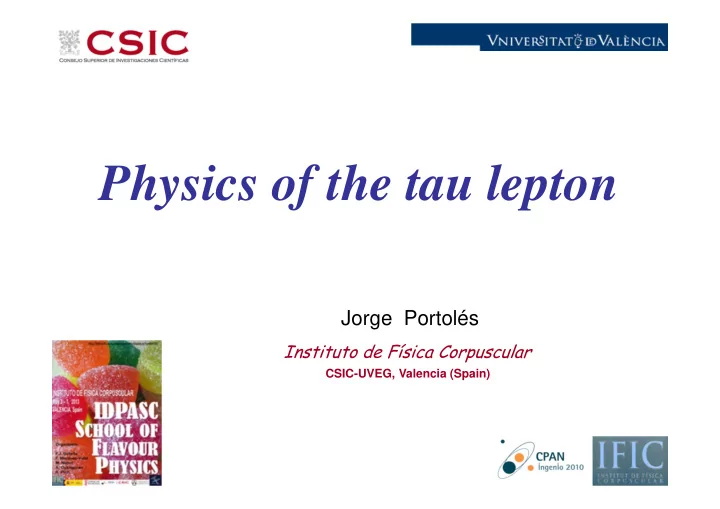

Physics of the tau lepton Jorge Portolés Instituto de Física Corpuscular CSIC-UVEG, Valencia (Spain)
Leptons [1] Discovery of the tau lepton SLAC-LBL (SLAC,1975), PLUTO (DESY,1976) “anomalous” e events [2] Momentum of e or DONuT (Direct Observation of Nu Tau), 2000
P ª Pseudoscalar meson Decay spectrum p, n ’ K [1.77682(16)] e (GeV ) 1 2
Experiment Estimate Process
Outline Leptonic decays Hadron decays Inclusive tau decays: S (M ) and |V us | I. II. Exclusive tau decays: Hadronization of QCD currents E. g.
[3] Charged current universality 1. Lepton decays
[4] 2. Hadron decays
What can we get? 1. Inclusive decays: full hadron spectra. Precision physics. Study of Standard Model parameters : S (M ), |V us |, m S Approximate 2. Exclusive decays: specific hadron spectrum. physics P = pseudoscalar meson Study of form factors, resonance parameters (M R , R ), hadronization of QCD currents.
2 2.1 Inclusive hadron decays 2
2 [5]
A A + V V S=1 S=0
A A + V J [6] V
[7] [8]
Working on the theoretical prediction of …. to get , ..... analytic everywhere except on the positive real axis analytic [9] Im(s) OPE 2 M Re(s) Quark-Hadron duality violation
Perturbative contribution [8,11,12] [3,10]
[14] [15] [13] Non-perturbative contributions [9, 13]
Reference Method Baikov et al. [12] CIPT, FOPT 0.1998 (43) - 0.332 (16) 0.1202 (19) Davier et al. [8] CIPT 0.2066 (70) -0.0059 (14) 0.344 (09) 0.1212 (11) Beneke-Jamin [16] BSR + FOPT 0.2042 (50) -0.007 (03) 0.316 (06) 0.1180 (08) Maltman-Yavin [17] PWM + CIPT - +0.012 (18) 0.321 (13) 0.1187 (16) Menke [18] CIPT, FOPT 0.2042 (50) - 0.342 (11) 0.1213 (12) Narison [19] CIPT, FOPT - - 0.324 (08) 0.1192 (10) Caprini-Fischer [20] BSR + CIPT 0.2037 (54) - 0.322 (16) - Abbas et al. [21] IFOPT 0.2037 (54) - 0.338 (10) - exp + CIPT Cvetic et al. [22] 0.2040 (40) - 0.341 (08) 0.1211 (10) Boito et al. [23] CIPT, DV - -0.002 (12) 0.347 (25) 0.1216 (27) FOPT, DV - -0.004 (12) 0.325 (18) 0.1191 (22) Pich [24] CIPT, FOPT 0.1995 (33) -0.0059 (14) 0.329 (13) 0.1198 (15) exp : Expansion in derivatives of s CIPT : Contour-improved perturbation theory FOPT : Fixed-order perturbation theory PWM : Pinched-weight moments BSR : Borel summation of renormalon series DV : Duality violation IFOPT: Improved FOPT
m S and |V us | from inclusive tau data decays [25, 26]
[Gamiz, 05]
V us Unitarity (2005) RBC/UK (2009) 0.23 Expts QCD, 06 0.2275 (2005) V 0.225 (2007) us M = Maltman (2009) 0.2225 B CHPT+ P = Pich (2013) JOP LR 0.22 (2004) BT 0.2175 CHPT+ (2004) N C, (2005) M P LR = Leutwyler-Roos (1984) BT = Bijnens-Talavera (2003) Expts = FLAVIAnet WG (2010) JOP = Jamin-Oller-Pich (2004) CHPT+N C = Cirigliano et al (2006) B = A. Bazavov et al. (2012)
2.2 Exclusive hadron decays
Examples
[27,28] Phenomenological Lagrangians : Tree Level
[29,30,31] +
[32]
1. Inclusive decays: full hadron spectra. Precision physics. Study of Standard Model parameters : S (M ), |V us |, m S 2. Exclusive decays: specific hadron spectrum. Approximate physics P = pseudoscalar meson Study of form factors, resonance parameters (M R , R ), hadronization of QCD currents.
References [1] J. Adam, et al., [MEG Collaboration], arXiv:1303.0754 [hep-ex]. [2] H. Albrecht, et al., [ARGUS Collaboration], Phys. Lett. 246 (1990) 278. [3] W.J. Marciano, A. Sirlin, Phys. Rev. Lett. 61 (1988) 1815. [4] J.H. Kühn, E. Mirkes, Z. Phys. C56 (1992) 661. Erratum: Z. Phys. C67 (1995) 364. [5] C. Itzykson, J-B. Zuber, Quantum Field Theory, McGraw-Hill Co. (1985) p.246. [6] Heavy Flavour Averaging Group, http://www.slac.stanford.edu/xorg/hfag/ [7] M. Davier, A. Höcker, Z. Zhang, Rev. Mod. Phys. 78 (2006) 1043. [8] M. Davier et al., Eur. Phys. J. C56 (2008) 305. [9] E. Braaten, S. Narison, A. Pich, Nucl. Phys. B373 (1992) 581. [10] J. Erler, Rev. Mex. Fis. 50 (2004) 200. [11] F. Le Diberder, A. Pich, Phys. Lett. B286 (1992) 147. [12] P.A. Baikov, K.G. Chetyrkin, J.H. Kühn, Phys. Rev. Lett. 101 (2008) 012002. [13] M.A. Shifman, A.I. Vainshtein, V.I. Zakharov, Nucl. Phys. B147 (1979) 385, 448. [14] C. McNeile et al, Phys. Rev. D87 (2013) 034503. [15] M. Jamin, Phys. Lett. B538 (2002) 71. [16] M. Beneke, M. Jamin, JHEP 0809 (2008) 044. [17] K. Maltman, T. Yavin, Phys. Rev. D78 (2008) 094020. [18] S. Menke, arXiv:0904.1796 [hep-ph]. [19] S. Narison, Phys. Lett. B673 (2009) 30. [20] I. Caprini, J. Fischer, Phys. Rev. D84 (2011) 054019. [21] G. Abbas et al., Phys. Rev. D87 (2013) 014008. [22] G. Cvetic et al., Phys. Rev. D82 (2010) 093007. [23] D. Boito et al., Phys. Rev. D85 (2012) 093015.
[24] A. Pich, arXiv:1303.2262 [hep-ph]. [25] E. Gámiz et al., Phys. Rev. Lett. 94 (2005) 011803. [26] A. Pich, arXiv:1301.4474 [hep-ph]. [27] G. Ecker et al., Nucl. Phys. B321 (1989) 311. [28] J. Portolés, AIP Conf.Proc. 1322 (2010) 178. [29] G. Ecker et al., Phys. Lett. B223 (1989) 425. [30] F. Guerrero, A. Pich, Phys. Lett. B412 (1997) 382. [31] A. Pich, J. Portolés, Phys.Rev. D63 (2001) 093005. [32] D. Gómez Dumm et al, Phys. Lett. B685 (2010) 158.
Recommend
More recommend